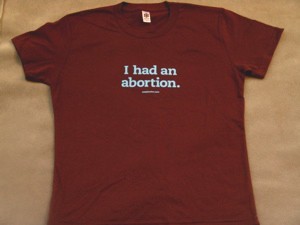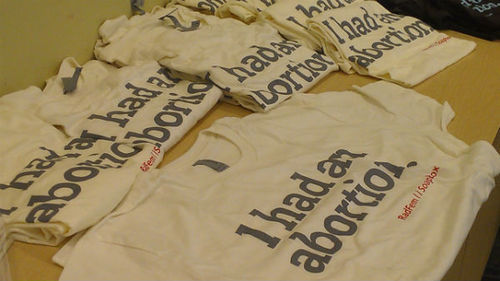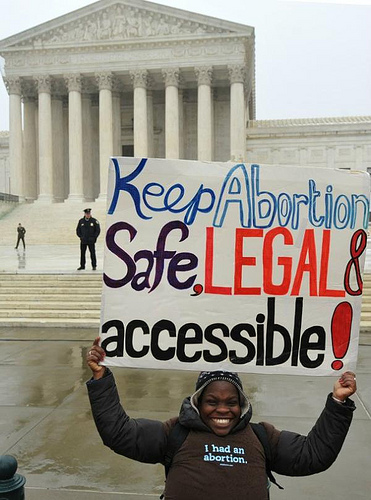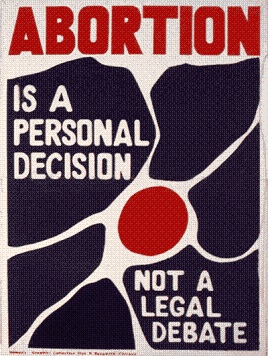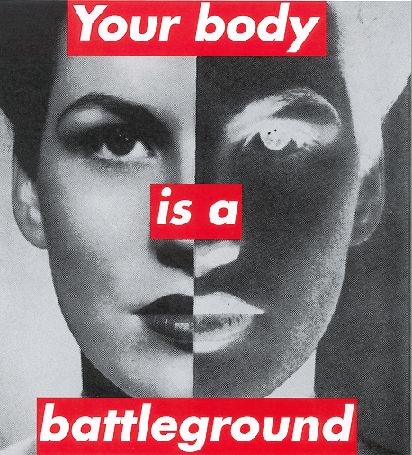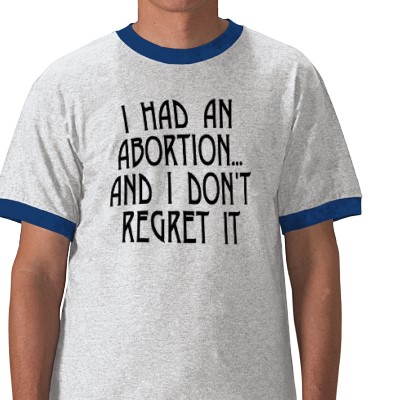"I Had an Abortion": A Feminist Analysis of the Abortion Debate
Elizabeth Kuechenmeister
This article explores the rhetoric surrounding the controversial "I Had an Abortion" t-shirt, sold by Planned Parenthood in 2005-2006. In order to understand the rhetorical impact of the t-shirt, Burkean dramatism is used to identify what terms are added and what terms are overlooked. A dramatistic analysis of both pro-choice and pro-life rhetoric is included to position the t-shirt in the abortion debate.
"I Had an Abortion." This simple statement identifying a past experience is a powerful declaration of belief and identity. It unapologetically communicates a decision that many people find controversial and shameful. To be able to speak this statement is to reveal one’s most personal, hidden thoughts. Much of the rhetoric concerning this issue, however, denies women the right to speak. The rhetoric on both sides implies that the act of abortion is shameful and should be hidden. However, to refuse the limitations set by this rhetoric and instead declare one’s role in the act is an empowering move, which allows women to find support from others through the sharing of their experiences. What kind of empowerment is found through expressing this identity through words on a t-shirt? While some have written off this "I Had an Abortion" t-shirt as pro-choice activism from the far radical left, this study explores this rhetorical space of the t-shirt as valuable to a deeper understanding of this shirt's purpose.
The "I Had an Abortion" t-shirt found its origins in 2005 pro-choice activism. Jennifer Baumgardner, a feminist and pro-choice activist, decided to create a way for women to communicate their experience with abortion, while at the same time refusing to be shamed for it. In association with other pro-choice feminists, Baumgardner worked on the 2005 film Speak Out: I Had an Abortion, a documentary involving real women who share their abortion experiences. She also designed a line of cards to be handed out at Planned Parenthood clinics, as well as t-shirts that declared "I Had an Abortion." The item to gain the most attention, however, was the t-shirt. It received very mixed reviews: the public, confrontational nature of the t-shirt seemed to contrast with most people’s understanding of the abortion issue, which is private. To many, putting a personal statement on a t-shirt appeared to make light of abortion, as if the t-shirt were commercializing the act. Viewing the t-shirts as too radical for many pro-choice activists, many Planned Parenthood clinics refused to sell them so as to not to isolate supporters. The shirts are currently available for sale online, and they have supporters who are working to reduce the stigma of abortion through alternative means..
The act of stating a personal belief on the public space of a t-shirt is an interesting type of rhetorical move. To place the words "I Had an Abortion" on the rhetorical space of a pop culture element—particularly one which identifies something personal about the wearer of these words—offers something unprecedented to the pro-choice movement. The purpose of this study, then, is to interrogate the motives behind the "I Had an Abortion" t-shirt in order to discover how it fits into current pro-choice rhetoric and how it reacts to pro-life rhetoric. What, precisely, is the rhetorical impact of this t-shirt? Does it mesh with the goals of the pro-choice movement, and does it effectively respond to pro-life arguments? This article will explore the effectiveness of the pro-choice message as printed on a t-shirt in an attempt to gain greater insight into the impact of this type of personal message in the abortion debate. To structure this analysis, Burke's Pentad is a useful method to explore the effect of the t-shirt and how the t-shirt fits within pro-choice rhetoric.
Kenneth Burke, in his theoretical work A Grammar of Motives, argues that all discussion of motives can be organized into a dramatistic structure, including the act (what happened), scene (when or where it happened), agent (who did it), agency (how it was done), and purpose (why it was done) (xv). These five key terms of dramatism, also called the Pentad, enable critics to analyze specific aspects of a situation to discover the underlying motives that drive its rhetoric. This method, Burke argues, enables the critic to analyze the rhetor’s language and define his or her motives from the analysis. Thus, Burke’s Pentad forms the foundation for this analysis.
The Personal is Political: Pro-Choice Rhetoric
In order to analyze how the "I Had an Abortion" t-shirt fits into current abortion rhetoric, an interrogation needs to be made into the motives of both sides of the issue. To begin, the vast majority of pro-choice rhetoric focuses on one dramatic element: purpose. In fact, the very name of the movement—"pro-choice"—indicates its purpose: to provide a woman with a choice to decide for herself whether or not abortion is right for her. The National Organization for Women (NOW) website declares that "reproductive justice is every woman’s right" (Mendez). Purpose is emphasized above all other pentadic elements, highlighting political injustice and the oppressive conservative social system in order to achieve its mission of keeping abortion legal and providing women a legal right to choose.
A bumper sticker for sale on the NOW website states, "Keep your laws off my body." This statement gets at the heart of pro-choice rhetoric, as its goal is to keep women’s choice legal. While this statement is to a lesser extent focusing on the agent ("my body"), the purpose is emphasized in the reference to laws—laws that attempt to restrict abortion rights. Therefore, the pro-choice movement emphasizes the political and social aspects of the abortion issue above all others, as the main goal of its rhetoric is to argue for women’s choice.
While it might make sense for the pro-choice movement to focus on the agent, very little of its rhetoric makes any reference to the woman herself. Instead, the situation is abstracted to become a public, political issue, far reserved from personal bodies. Instead of the second-wave feminist saying, "the personal is political," it might be said that the personal is ignored, while the abstract is political instead. A bumper sticker communicates this political bent of the movement, saying "I’m pro-choice and I vote" ("NOW Store Catalog"). This identifies a person with a belief, but both the act and the agent of the situation are abstracted into a political framework.
All of these familiar elements of pro-choice rhetoric are different from the method the "I Had an Abortion" t-shirt takes. These bumper stickers, protest signs, and posters focus more on the political purpose of the message, as a way to deflect attention from the act. The t-shirt, in contrast, directly names the actor in the act itself. Pro-choice rhetoric generally
avoids this strategy, for fear of implicitly blaming the actor. Furthermore, naming the act of abortion as something a woman actually chooses to do—rather than just having the vague, unspecified choice of whether or not to do it—may weaken their position in the eyes of the pro-life advocate, who objects to the act on moral grounds.However, as unflinching and direct as the t-shirt may be, it points to the ultimate goal of the pro-choice position in a better way than other approaches possibly have been. While it is undoubtedly an offensive message (which will be discussed later), the t-shirt's message is clear that it is not afraid to deal with the real issue: that real women do get abortions, and to be afraid to speak of the act or the actor only weakens the pro-choice position that abortion should be a woman's choice.
Abortion is Murder: Pro-Life Rhetoric and the Act
The exact opposite is true, however, for the pro-life movement. For as much as the pro-choice side works to carefully avoid any mention of the abortion act, the pro-life side focuses almost exclusively on the act, identifying other dramatic aspects only in relation to it. Familiar pro-life arguments use graphic descriptions of the act and images of bloody, mangled fetuses to gain support. These images remind viewers of the act of abortion, in terms of reminding them what is lost when the act is performed. In sum, pro-life rhetoric is highly specific and detailed, focused almost exclusively on the act.
What is most interesting, in fact, is that the pro-choice "I Had an Abortion" t-shirt is also focused directly on the act and actor itself, though for quite a different purpose. Focusing on this part of the Pentad, the Act, can help to explain how the t-shirt is simultaneously offensive and a fitting response to the pro-life viewpoint.
By focusing on the act, pro-life movement rhetoric gives explicit details in pictures and words to establish that abortion is an inhumane act. In fact, the use of visuals has been shown to be quite effective in persuading their case. Celeste Michelle Condit, in her book Decoding Abortion Rhetoric: Communicating Social Change, describes how in the early years of the movement pro-life supporters would bring pickled fetuses in jars to legislative hearings. Later, these images would be reproduced on billboards, fliers, and signs, as well as in films (82). Protest signs displaying aborted fetuses or dead babies are common images in pro-life rhetoric, as well as images of fetuses in the womb. This visual rhetoric is powerfully confrontational, intending to play on the emotions of the viewer in order to persuade and gain support.
The pro-life movement also uses metaphor as a way to focus on the act of abortion. In order to establish that the act takes away human life, metaphor is used to show the correlations between "fetus" and "human." Metaphor is used widely by the movement as a method of identification. Slogans like "abortion is murder" and "the fetus is a human" identify A with B, directly illustrating the connection. One common picture shows the feet of a 10-week-old fetus, held between the fingers of an adult’s hand for comparison. This works for the pro-life movement through its use of metaphor, as the picture seems to state that the fetus, with its tiny feet, is a human. Condit describes the positive audience reaction to this photo, noting that "many viewers responded to pictures of the fetal feet with loving 'oohs' and 'aahs'" (88). The metaphors used all focus on the act, establishing it as the center of the debate.
While the agent and the purpose are often mentioned as well in pro-life rhetoric, they are mentioned only in terms of the act. That is to say, the act defines the agent and purpose. For example, the woman who aborts her child is identified as a murderer and as a selfish person, as someone who did not think or did not care about the life inside of her. The reasons why a woman chooses abortion are equated as well with murder and with selfishness, as they are defined in the context of the act. As the act of abortion defines the agent, the woman who chooses abortion can never be explained or excused outside of the context of the act: she will always be a murderer. In the same way, no purpose can be explained or excused, as all reasons for abortion are tied to the act itself, and are deemed insufficient to excuse murder.
However, the "I Had an Abortion" t-shirt uses this focus on the dramatic element of Act and Agent as a way to communicate its pro-choice message. Taking the familiar strategy from pro-life rhetoric, the t-shirt directly names the act and agent—two things pro-choice rhetoric fails to do. In this way, the t-shirt clearly identifies the wearer of the shirt as participating in the act, which is a shocking and offensive statement. Indeed, to many on both sides of the debate, the t-shirt has too shocking of a message—people end up focusing more on their distaste seeing the word "abortion" on a t-shirt than considering the message the t-shirt is attempting to convey.
In the same way, the unflinching directness of the pro-life focus on the act—the jars of pickled fetuses and the graphic images of abortions—end up turning many away from the movement, as the medical procedure itself has become so closely connected to morality in our society. This shocking message on the t-shirt has caused it to be ignored by pro-choice supporters, for fear of it appearing to promote abortion. It has also gotten attention from pro-life supporters, for the wrong reasons: many pro-life views of the shirt see it only as bragging about the act, as it seems to advertise itself on the t-shirt.
Scene: Invisible Bodies
This dramatistic analysis of both sides of the abortion debate exposes one essential element that has been ignored in both pro-life and pro-choice rhetoric. This element is the scene, or the woman’s body. Pro-choice advocates’ attempts to abstract the issue to make it more socially acceptable has not only ignored the woman (agent), but also her body. Pro-life activists use the agent to blame for the act, and equally ignore the scene of abortion as well. By reminding viewers of the humanity of the woman in focusing on the debate around her body, pro-choice arguments could personalize their political rhetoric and gather support through relating to real women and their experiences.
The "I Had an Abortion" t-shirt, I argue, does just that. By placing this sort of direct identification statement on a t-shirt, the shirt reminds the viewer of the scene where abortion occurs: the female body. Too frequently, the politicization of the abortion issue has shifted pro-choice arguments’ focus to the alternative scene of the courtroom or the voting booth. This over-legalization of the debate has taken attention away from the real scene of the debate. Because of this shift in focus, pro-choice arguments have abstracted themselves to the point that they have forgotten what the debate is really about: what can and cannot be done on a woman’s body. The t-shirt, then, functions as a consciousness-raising tactic that unapologetically frames the debate in terms of the woman’s body, thus personalizing the formerly political debate.
While some may argue that the t-shirt's direct statement may be offensive to some, the deeper purpose of the t-shirt is to call attention to the site of abortion, as a way to make the point clear: abortion should be a choice that women make, as their body is the scene of the event. Placing the statement "I Had an Abortion" on other products such as notecards, posters, pamphlets, or bumper stickers has a very different effect from placing the same statement on a human body. The t-shirt demonstrates the concrete, physical location of the debate, forcing both sides of the issue to acknowledge that abortion is not an issue that can be made abstract or made into a metaphor. It is a reality for women everywhere, and by placing that statement across a woman's chest—however offensive or distasteful it may be—prevents the viewer from ignoring the scene of the event: the woman's body.
The T-Shirt
The message’s public location is an important point, as its location is vital to its rhetorical success. For too long, pro-choice rhetoric has ignored the scene of the abortion debate—the woman’s body—feeling that abortion is too taboo a subject to discuss in any detail—a phenomenon Bitch journalist Rebecca Hyman describes as "the current unspoken contradiction of the pro-choice movement." This silence about the issue has led women to believe that abortions are shameful, whether one supports them or not. In turn, this weakens the pro-choice movement’s rhetoric: how can one support a practice that is shameful to talk about?
In a New York Times editorial, Barbara Ehrenreich observes that currently in American society, "Abortion is legal—it’s just not supposed to be mentioned or acknowledged as an acceptable option" (Hyman). Because of this silence, pro-choice rhetoric inadvertently supports pro-life’s attempts to outlaw abortion. Hyman further observes that "keeping quiet might seem like a smart political tactic, but when women muzzle themselves because they are afraid, their silence can masquerade as the appearance of support for the anti-choice agenda." Thus, the public location of the message is essential to break the silence surrounding abortion and challenge its social stigma.
The t-shirt’s intended goal is to open up forums for discussion about abortion experiences, without fear of judgment. Women who have gone through the experience often feel they have a dirty secret—something they think they should hide and feel guilty about. By providing a space for women to share their experiences, the shirt helps to bring the focus back to the scene and in turn to the agent and act, thus personalizing an abstract debate. Baumgardner, the shirt’s creator, believes that the more women talk about abortion, the less taboo it will become. She says that "the power of the shirt lies in its challenging nature. It is a philosophical goad to reflect on the source and the grounds of our shame [. . .] the experience (and the t-shirt) are yours and you don’t have to be sorry" ("The Shirt"). Planned Parenthood of America describes the shirt as "an affirmation that abortion is not shameful. It enables women who choose to wear the t-shirt to take ownership of their lives and their decisions" ("I Had an Abortion T-Shirt").
The message’s placement on a t-shirt has a normalizing effect as well. Calling for pro-choice supporters to challenge the stigma of abortion, graduate student and documentary filmmaker Penny Lane explains that "people need to accept abortion for what it is: a valid part of the reproductive spectrum. I want it to be seen as normal; if 1.3 million women in this country have one every year, it’s gotta be normal" (Barcella). By reproducing this message on a t-shirt, its ubiquity is an attempt to normalize the act. As long as pro-choice rhetoric ends its implicit stigmatizing of abortions, it will distinguish its movement from pro-life arguments, which still focus on constructing a stigma around the act of abortion. One woman explained the shirts’ normalizing influence, noting that "they’re almost like slang, desensitizing a word" (Barcella). Just as the shirt calls attention to the scene of the female body, the statement reflects the reality that real women choose to have abortions, which normalizes the practice.
What might be most striking about the shirt is its unflinching directness. This can work both for and against the shirt, as it communicates its idea but also seems to intimidate the viewer at the same time. Lisa Boyce, Planned Parenthood of Wisconsin Vice President, analyzes the shirt and defends its message: "It’s not a cavalier declaration. It delivers a message that is intended to confront and subvert the sense of shame" (Williams). While the shirt’s main goal is to encourage communication, it does so in a confrontational way. As such, reaction has been mixed.
Indeed, this directness is perhaps the greatest weakness of the t-shirt. As mentioned earlier, its focus on the act and the agent—without making a morality argument as pro-life rhetoric does, connecting abortion and the woman who aborts with murder—is shocking to most people, as this is a new method for conveying the pro-choice message. As people have become more familiar with the abstract arguments focusing on purpose, this t-shirt does not blame the woman for her act—instead, it seems to blame the rest of us for making the act such a stigma in our society. This previously unheard of tactic is just as likely to offend and continue to stigmatize the act and actor, because of its intended directness, as it is to release the wearer from stigma and open up a dialogue about abortion. In any case, whether or not the t-shirt is rhetorically effective, the methods it uses can be especially helpful in understanding how to articulate a pro-life or pro-choice argument more effectively.
Conclusions
In effect, the shirt declares a personal freedom from stigma. The shirt’s attitude—its focus on the scene of the message, the woman’s body—functions as an intermediary step, resulting in attention to the human body and humanity in general, leading to a focus on the agent. This is a new turn for pro-choice rhetoric. Instead of making the act define the agent, as pro-life rhetoric does, the agent has power over the act and is able to define it according to the agent’s own narrative. By focusing on personal experience, the t-shirt gives the agent power to take control by creating a scene to open up the conversation. As Hyman noted earlier, the t-shirt is "only an opening line"—the rest comes from the woman herself.
If we assume the statement "I Had an Abortion" to be an opening line for a narrative, then what might the rest of that narrative say in order to support the t-shirt’s focus on agent? Narratives, too, can emphasize certain dramatic elements over others. As a general trend, both the pro-life and pro-choice movements have begun in the past few years to use women’s personal stories of abortion to aid their arguments. The use of personal testimony can be quite effective for supporting any argument, and since the "I Had an Abortion" t-shirt, narrative has become essential to the rhetoric of both sides. As elsewhere, the use of personal testimony can be quite effective for supporting any argument, and since the "I Had an Abortion" t-shirt, narrative has become essential to the rhetoric of both sides.
However, this is not to say that the t-shirt is a main cause for this trend. The t-shirt did function as the first in this narrative trend, but may be only one of many factors that led to this increased focus on agent. In any case, these narratives and the overall encouragement of speaking women’s abortion stories is an effective rhetorical move, as this t-shirt seeks to emulate.
In keeping with the t-shirt’s focus on scene, narratives distributed by pro-choice rhetoric emphasize the dramatic elements of both agent and purpose. Even though agent is a major focus (a given, since the genre is personal narrative), purpose is still prevalent throughout the various narratives in their discussion of choice. The following excerpt from one woman’s story illustrates this focus on agent and purpose:
A week and a half ago, I had an abortion. I am 15 years old. The father is gone which is a good thing and my family is supporting me all the way. If you’d look at me, I am the usual junior in high school. I am involved in numerous activities and have a lot of friends. But I met a boy from the other side of the tracks that ended up making me turn my life around in the wrong direction. I don’t blame him for the reason why I got pregnant. I blame myself. But out of everything, I don't regret having an abortion. To me, it was the right thing for me to do. [. . .] Before I had the abortion, I saw the baby on the screen and I asked what it was. It was a girl. I was left alone in the room for a minute and in that minute, I said I loved her and that I know this was right for me to do. I also told her not to be scared. Ever since I left that clinic, I have known that I did the right thing. I also want to be a counselor who works in an abortion clinic so I can help people go through what I went through. To let them know that it is ok. And that they’ll be ok too. ("Jill’s Story")
This emotional appeal, used to argue in support of the pro-choice movement, is a tactic formerly taken up by pro-life rhetors. The effectiveness of pro-life’s images of bloody, dead babies uses the same kind of emotional appeal Jill’s story does, with quite different effects. Jill’s story also goes on to establish her Christianity and tells of how she prayed to God to look after her unborn child—thus re-appropriating another tactic of the pro-life movement: morality arguments.
What is most important about this story—and the t-shirt—is the focus on agent. Jill’s story is focused on the "I"—as in, "I blame myself" and "I have known that I did the right thing." At no time does Jill try to explain her situation in terms of outside pressures or blame other factors for her decision. Jill clearly names her choice of abortion as her own, and she informs the reader that she is right and not shamed by her decision. Jill’s narrative challenges the stigma of abortion, illustrating how a woman can make the decision logically and not question it—thus illustrating the ultimate goal of the t-shirt at work.
Therefore, a study of the "I Had an Abortion" t-shirt can be useful to thinking about the logical flaws in the rhetoric of both sides of the abortion debate. Both sides ignore the scene (body) and agent (woman) of the act, preferring to abstract the subject or to moralize it. However, as this sample narrative of one woman's experience having an abortion, the debate is immediately humanized—it is no longer a law being argued in a courtroom; it is now a real event, one which happens to real women. Stigmatizing the act, whether implicitly or explicitly, only weakens the argument from each perspective.
This t-shirt, while we may find it offensive or intimidating, addresses the only relevant parts of the Pentad in this situation: the scene and agent. This study, then, may help us in our understanding of how to articulate a pro-choice or pro-life position more effectively, by focusing on narratives of women's own experiences with abortion. As Hyman explains, the t-shirt's message is "only an opening line"—the rest is up to us.
References
Barcella, Laura. “The A-Word.” Salon. 20 Sept. 2004. Web. 6 October 2012 http://www.salon.com/2004/09/20/t_shirts/.
Baumgardner, Jennifer. “The Shirt.” Abortion and Life. Sept. 2004. Web. 6 October 2012 http://abortionandlife.com/p/the-shirt/.
Burke, Kenneth. A Grammar of Motives and A Rhetoric of Motives. Los Angeles: U of CA P, 1962. Print.
Condit, Celeste Michele. Decoding Abortion Rhetoric: Communicating Social Change. Chicago: U of Illinois P, 1990. Print.
Hyman, Rebecca. “Full Frontal Offense: Taking Abortion Rights to the Tees.” Bitch Magazine. December 2004. Web. 6 October 2012 http://bitchmagazine.org/article/full-frontal-offense.
“I Had an Abortion T-Shirt.” Planned Parenthood of Louisiana and the Mississippi Delta. 27 July 2010. Web.
“Jill’s Story.” Feminist Women’s Health Center. 21 Sept. 1999. 6 October 2012 http://www.fwhc.org/stories/jill.htm.
Mendez, Zenaida. “Reproductive Justice is Every Woman’s Right.” NOW. Fall 2006. Web. 6 October 2012 http://www.now.org/nnt/fall-2006/reproductive_justice.html.
Myrsiades, Linda. Splitting the Baby: The Culture of Abortion in Literature and Law, Rhetoric and Cartoons. New York: Peter Lang, 2002. Print.
National Organization for Women (NOW) Store Catalog. NOW. 26 May 2012. Web.
Planned Parenthood of Louisiana and the Mississippi Delta. “I Had an Abortion T-Shirt.” 27 July 2010. Web.
“The Shirt.” Abortion and Life. Sept. 2004. 6 October 2012 http://abortionandlife.com/p/the-shirt/
Williams, Scott. “‘I Had an Abortion’ T-Shirt Stirs Debate.” JS Online. 9 Nov. 2006. Web.
